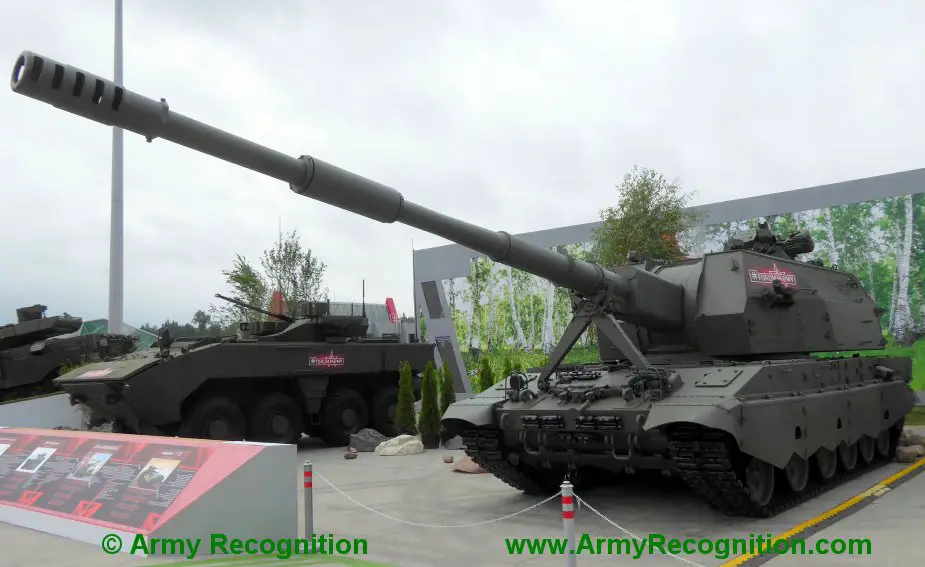Analysis: Russia reforms missile and artillery troops
The Russian Defense Ministry launched an experiment to increase the effectiveness of missile troops and artillery. Besides the design of new weapons and the upgrade of available ones, a new staff matrix for battalions, regiments and brigades is drafted. The latest Center-2019 exercise tested the new artillery concept, the Military-Industrial Courier writes.

2S35 Koaitsyia-SV (Picture source: Army Recognition)
The artillery reform is mostly closed for the public. The developments may look as chaos to an amateur. For example, the Ground Forces have to receive the latest 2S35 Koalitsiya-SV self-propelled artillery guns in the near future. At the same time, the Defense Ministry is returning Cold War legacy of Pion 2S7 long-range self-propelled guns and super heavy 2S4 Tyulpan mortars. Besides, Krasnopol guided projectiles have returned although their production stopped in the mid-1990s.
Experts want to understand how missile troops and artillery will look like in the near future and why old weapons are returning. They also assessed the effectiveness of innovations at maneuvers. The main guideline of artillery development is its maximum integration into the so-called single information space. In other words, missiles and artillery have to obtain target information in real-time and destroy them.
The first stage has been accomplished by now. Artillery receives information directly from drones and frontline units. The latter transmits all the necessary information by Strelets reconnaissance and communication system. Artillery and missile troops successfully engaged Strelets in Syria. The military now face a more difficult task.
The troops began to introduce the concept of reconnaissance-strike forces (RUK). They operate as follows: a battery or battalion operates with drones or personnel equipped with Strelets. The interaction goes directly between drones or Strelets with artillerymen. However, the military leadership now believes the reconnaissance-strike force is outdated and no longer meets modern requirements. It is replaced by a reconnaissance-fire force (ROK) built on netcentric principle of modern wars and conflicts.
ROK operation is simple. All units on the battlefield are armed with automatic control systems and report the detected targets. Information also comes from drones and electronic reconnaissance. The data are transmitted to the superior command. The headquarters use the information and distribute targets between artillery units. They take into account numerous factors, starting from the tactical and operational situation on the battlefield up to the available round of artillery munitions and the weather. Artillery in positions receives target coordinates and the necessary round of munitions to destroy it. It remains for the men to accomplish the mission and engage in the next one.
ROK can be effective to the maximum if missile and artillery units are integrated into a single information space. The Defense Ministry has been working since 2015 to arm artillery and missile troops with modern radio stations and automatic control terminals.
The latest Koalitsia-SV, Msta-S 2S19M2 152mm self-propelled artillery guns, Tornado-S and Uragan-M1 MLRS were created for the integration into single information space. Older Acacia 2S1, Gvozdika 2S3, Uragan and Grad MLRS have to be upgraded for that. Active work is ongoing and the program to upgrade Grad was launched in 2019.
The upgraded weapons have some restrictions against the new ones. For example, Koalitsia, Tornado and Uragan-M1 independently make all the calculations after receiving the combat mission. Their control systems place the launchers or guns to the necessary angle. The operator has only to press the button. Older weapons do not have such a level of automation. Upon obtaining the firing data, the operators have to do everything themselves - raise the weapon to the necessary angle, calculate ammunition consumption, etc.
The delivery of new artillery guns made it necessary to revise the matrix of artillery units. In particular, artillery regiments of motorized rifle and tank divisions began to get heavy Uragan batteries.
Until recently, only artillery brigades were armed with the MLRS. The latest Uragan-M1 with an arsenal of precision munitions will soon replace them in artillery brigades. The freed Uragan will reinforce the firepower of motorized infantry and tank divisions. One such MLRS battery is an impressive force capable of creating major difficulties for the adversary.
Koalitsia-SV and 2S19M2 Msta-S will gradually replace old but upgraded Msta-S 2S19 in artillery brigades. The latter will not be scrapped but sent to artillery battalions and regiments of combined arms brigades, as well as artillery battalions of motorized infantry and tank brigades.
The Syrian combat experience confirmed the high effectiveness of towed artillery. Batteries and battalions of D-30 and Msta-B 2A65 howitzers can march hundreds of kilometers. However, tracked guns do not boast such mobility. It was initially expected that towed guns would be replaced by automobile-mounted Koalitsia-SV (the turret with 152mm gun is mounted on an 8x8 truck). However, the Syrian experience showed that ordinary prime movers with trailed howitzers present major advantages against wheeled guns. Therefore, the Ground Forces will keep artillery brigades armed with towed howitzers Msta-B 2A65. It is unclear whether the towed Koalitsia-SV will replace them. The Defense Ministry voiced such plans, but so far the work to create a towed Koalitsia has not begun.
Syria gave the second breath to towed 122mm D-30 howitzers which have been gradually decommissioned since early 2000s. The artillery guns remained in the Airborne Forces, but will likely return to the Ground Forces in the near future, the Military-Industrial Courier said.
© Copyright 2019 TASS / Army Recognition Group SPRL. All rights reserved. This material may not be published, broadcast, rewritten or redistributed.


























